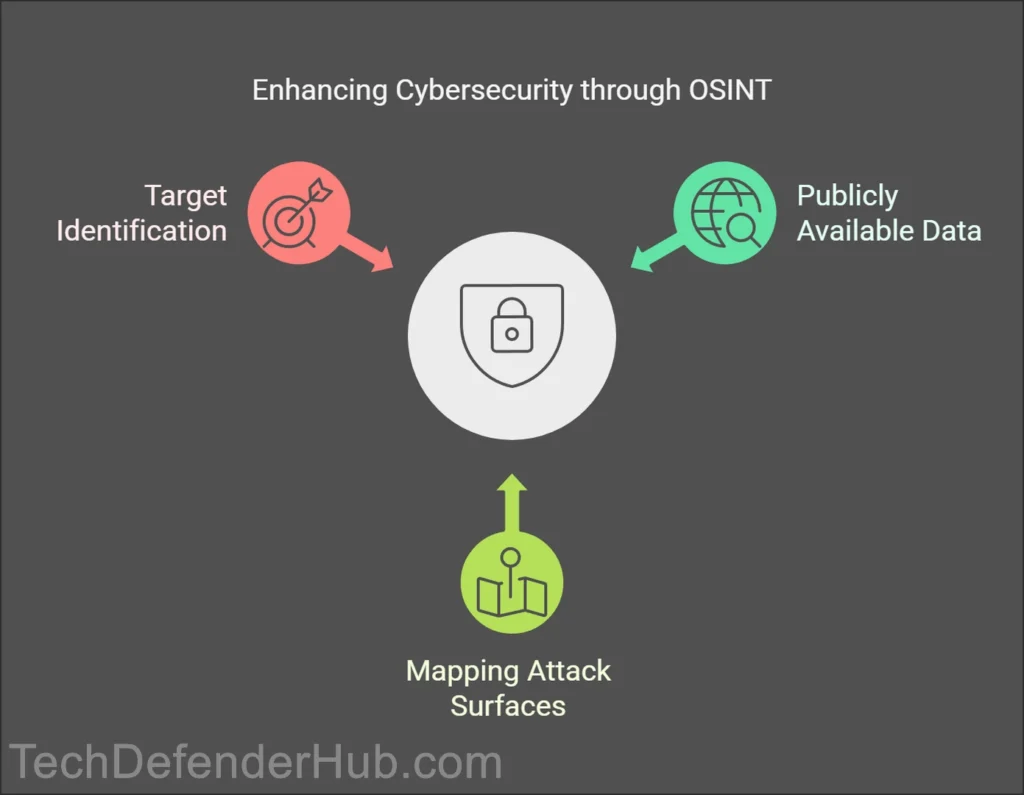In the evolving landscape of cybersecurity, Open Source Intelligence (OSINT) has emerged as a critical tool for identifying potential targets and mitigating risks. Whether you’re a security professional defending an organization or a threat actor probing for weaknesses, OSINT provides a treasure trove of publicly available data to map attack surfaces. But what information should you collect, and how can it be used to strengthen defenses? This post breaks down the essentials of target identification through OSINT, offering actionable insights for cybersecurity teams and enthusiasts.

What Is OSINT, and Why Does Target Identification Matter?
OSINT refers to the process of gathering, analyzing, and leveraging publicly accessible information from sources like websites, social media, domain records, and government databases. In cybersecurity, OSINT is used to:
- Map an organization’s digital footprint.
- Identify vulnerabilities exposed to the public internet.
- Anticipate attack vectors that adversaries might exploit.
Target identification is the first step in both penetration testing and threat hunting. By understanding what information is publicly available, defenders can proactively secure assets, while attackers use the same data to plan intrusions.
Key Types of Information to Collect
1. Digital Footprint Analysis
- Domains and Subdomains: Identify all domains and subdomains linked to a target. Tools like Amass or Sublist3r automate this process.
- IP Addresses and Infrastructure: Use Shodan or Censys to discover exposed servers, databases, or IoT devices.
- SSL/TLS Certificates: Extract metadata from certificates (e.g., organization names, expiration dates) using Crt.sh.
2. Social Media and Employee Data
- Employee Profiles: LinkedIn, Twitter, and GitHub profiles often reveal roles, technologies used, and potential phishing targets.
- Data Leaks: Search platforms like Have I Been Pwned or DeHashed for exposed credentials linked to corporate emails.
3. Public Records and Archives
- WHOIS Data: Domain registration details (registrant name, contact info) via WHOIS Lookup.
- Historical Data: Use the Wayback Machine to view archived versions of websites, which may expose outdated or sensitive content.
4. Technical Configurations
- Open Ports and Services: Run Nmap scans to detect open ports (e.g., SSH, RDP) that attackers could exploit.
- Cloud Storage Buckets: Misconfigured AWS S3 buckets or Azure blobs often leak data—tools like Grayhat Warfare can help locate them.
5. Geolocation and Physical Assets
- Satellite Imagery: Google Earth or Sentinel Hub can reveal physical facilities, data centers, or supply chain hubs.
- Wi-Fi Networks: Wardriving tools like Wigle map nearby wireless networks linked to a target.
Essential OSINT Tools and Techniques
Tools for Data Collection
| Tool | Use Case |
|---|---|
| Maltego | Visualize relationships between domains, IPs, and employees. |
| theHarvester | Gather emails, subdomains, and virtual hosts. |
| SpiderFoot | Automate footprinting across 100+ data sources. |
| Recon-ng | Modular framework for targeted reconnaissance. |
Techniques for Effective OSINT
- Passive Reconnaissance: Collect data without interacting directly with the target (e.g., scraping public databases).
- Active Reconnaissance: Engage with the target’s systems (e.g., port scanning) while avoiding detection.
- Metadata Analysis: Extract hidden details from documents, images, or network traffic.
Real-World Applications of OSINT
Case Study: Exposed Cloud Storage in a Healthcare Firm
A cybersecurity team used Grayhat Warfare to discover an unsecured AWS S3 bucket containing patient records. By identifying and securing the bucket, they prevented a potential breach.
Case Study: Phishing Campaign Prevention
By analyzing LinkedIn profiles and GitHub repositories, a financial institution identified employees with access to sensitive systems. They enforced stricter email security protocols to counter spear-phishing attempts.
Best Practices for Ethical OSINT
- Stay Legal: Only collect publicly available data—avoid unauthorized access or scraping.
- Verify Accuracy: Cross-check findings with multiple sources to reduce false positives.
- Prioritize Relevance: Focus on data that directly impacts security (e.g., exposed credentials, misconfigurations).
- Automate Wisely: Use tools like SpiderFoot for efficiency, but manually validate critical findings.
How OSINT Enhances Security Measures
- Proactive Threat Hunting: Identify vulnerabilities before attackers exploit them.
- Incident Response: Quickly map attack surfaces during a breach investigation.
- Brand Protection: Monitor for leaked intellectual property or counterfeit domains.
Conclusion: Turn Information into Action
Target identification via OSINT is not just about data collection—it’s about transforming raw information into actionable intelligence. By systematically mapping digital footprints, analyzing social media, and leveraging tools like Shodan or Maltego, security teams can stay one step ahead of adversaries.
Call to Action:
- Start with a free tool like theHarvester to map your organization’s public-facing assets.
- Train employees to minimize oversharing on social media.
- Regularly audit your digital footprint to close unintended exposure gaps.
In cybersecurity, knowledge is power. The more you know about your vulnerabilities, the better you can defend them. 🔍🔒
